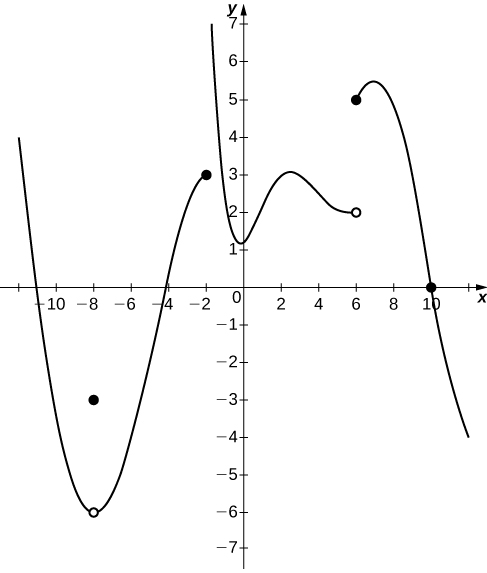2.4: Infinite Limit Exercises
In the following exercises, find the limit.
In the following exercises, consider the graph of the function \(y=f(x)\) shown here. Which of the statements about \(y=f(x)\) are true and which are false? Explain why a statement is false.

J46) \(\displaystyle \lim_{x→10}f(x)=0\)
J47) \(\displaystyle \lim_{x→−2^+}f(x)=3\)
- Answer:
-
False; \(\displaystyle \lim_{x→−2^+}f(x)=+∞\)
J48) \(\displaystyle \lim_{x→−8}f(x)=f(−8)\)
J49) \(\displaystyle \lim_{x→6}f(x)=5\)
- Answer:
-
False; \(\displaystyle \lim_{x→6}f(x)\) DNE since\(\displaystyle \lim_{x→6^−}f(x)=2\) and \(\displaystyle \lim_{x→6^+}f(x)=5\).
J2.4.1)
a. \(\displaystyle \lim_{x→−3^+}\frac{x}{x+3}\)
b. \(\displaystyle \lim_{x→−3^-}\frac{x}{x+3}\)
c. \(\displaystyle \lim_{x→−3}\frac{x}{x+3}\)
- Answer:
- a. −∞
b. ∞
c. DNE
J2.4.2) \(\displaystyle \lim_{x→0}\ln |x|\)
J2.4.3)
a. \(\displaystyle \lim_{x→5^+}\frac{2}{x-5}\)
b. \(\displaystyle \lim_{x→5^-}\frac{2}{x-5}\)
c. \(\displaystyle \lim_{x→5}\frac{2}{x-5}\)
- Answer:
- a. ∞
b. −∞
c. DNE
J2.4.4)
a. \(\displaystyle \lim_{x→-2^+}\frac{x}{(x+2)^2}\)
b. \(\displaystyle \lim_{x→-2^-}\frac{x}{(x+2)^2}\)
c. \(\displaystyle \lim_{x→-2}\frac{x}{(x+2)^2}\)
J2.4.5)
a. \(\displaystyle \lim_{x→6^+}\frac{x}{(6-x)^2}\)
b. \(\displaystyle \lim_{x→6^-}\frac{x}{(6-x)^2}\)
c. \(\displaystyle \lim_{x→6}\frac{x}{(6-x)^2}\)
-
- Answer:
- a. ∞
b. ∞
c. ∞
J2.4.6)
a. \(\displaystyle \lim_{x→1^+}\frac{2x^2+7x−4}{x^2+x−2}\)
b. \(\displaystyle \lim_{x→1^−}\frac{2x^2+7x−4}{x^2+x−2}\)
c.\(\displaystyle \lim_{x→1}\frac{2x^2+7x−4}{x^2+x−2}\)
J2.4.7) \(\displaystyle \lim_{x→1}\frac{x^3−1}{x^2−1}\)
- Answer:
- \(\displaystyle lim_{x→1}\frac{x^3−1}{x^2−1}=\displaystyle \lim_{x→1}\frac{(x-1)(x^2+x+1)}{(x-1)(x+1)}=\displaystyle \lim_{x→1}\frac{x^2+x+1}{x+1}=\frac{3}{2}\)
J2.4.8) \(\displaystyle \lim_{x→1/2}\frac{2x}{2x−1}\)
J2.4.9) \(\displaystyle \lim_{x→1/2}\frac{2x^2+3x−2}{2x−1}\)
- Answer:
- \(\displaystyle \lim_{x→ 1/2}\frac{2x^2+3x−2}{2x−1}=\displaystyle \lim_{x→1/2}\frac{(2x−1)(x+2)}{2x−1}=\displaystyle \lim_{x→1/2}(x+2)=\frac{5}{2}\)
State the vertical asymptote for each function, if any.
J2.4.10) \(f(x)=\ln x\)
J2.4.11) \(g(x)=\frac{x+5}{x-4}\)
- Answer:
- \(x=4\)
J2.4.12) \(g(x)=\frac{7}{x+5}\)
J2.4.13) \(g(x)=\frac{7}{x}\)
- Answer:
- \(x=0\)
J2.4.14)
a. \(\displaystyle \lim_{x→\frac{\pi}{2}^+}\tan x=\)
b. \(\displaystyle \lim_{x→\frac{\pi}{2}^-}\tan x=\)
c. \(\displaystyle \lim_{x→\frac{\pi}{2}}\tan x=\)
d. Does \(f(x)=\tan x\) have a vertical asymptote at \(x=\frac{\pi}{2}\)?


